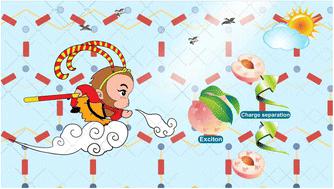当前位置:
X-MOL 学术
›
J. Mater. Chem. A
›
论文详情
Our official English website, www.x-mol.net, welcomes your
feedback! (Note: you will need to create a separate account there.)
Regulating the exciton binding energy of covalent triazine frameworks for enhancing photocatalysis
Journal of Materials Chemistry A ( IF 10.7 ) Pub Date : 2022-09-20 , DOI: 10.1039/d2ta06479k
Weijie Zhang 1 , Zhaozhang Deng 2 , Jiyong Deng 1 , Chak-Tong Au 1 , Yunfeng Liao 1 , Hai Yang 1 , Qingquan Liu 2
Journal of Materials Chemistry A ( IF 10.7 ) Pub Date : 2022-09-20 , DOI: 10.1039/d2ta06479k
Weijie Zhang 1 , Zhaozhang Deng 2 , Jiyong Deng 1 , Chak-Tong Au 1 , Yunfeng Liao 1 , Hai Yang 1 , Qingquan Liu 2
Affiliation

|
Strong excitonic effects are the major constraints hindering free charge carrier generation for conducting photocatalysis in polymeric semiconductors, which is usually inhibited by Frenkel excitons with intrinsically strong Coulomb interactions, severely limiting the photocatalytic activity of organic semiconductors. Minimizing the potential Coulomb interaction of Frenkel excitons is ideal for reducing energy loss and thus boosting the generation of charge carriers. Nonetheless, this has been long neglected and its development is still in its infancy in covalent triazine frameworks (CTFs). Herein, a series of CTFs were developed to promote exciton dissociation via a built-in dipole control strategy. Thiophene-rich CTFs deliver a reduction of exciton binding energy down to 97.5 meV to enable exciton dissociation. Thus, the facilitated generation and separation of photogenerated charge carriers over CTFs of thiophene-rich structures enabled the Ugi reaction and functionalization of thiophenols with higher yields than the benzyl analogue Ph-CTF, where boosting superoxide radical (O2˙−) and singlet oxygen (1O2) photogeneration via electron and energy transfer processes was facilitated, respectively. This architecture not only establishes a comprehensive understanding of regulating the exciton effect of polymeric semiconductors but also furnishes a feasible avenue for the rational design of polymer-based photocatalysts with highly efficient electron–hole separation from the exciton aspect.
中文翻译:

调节共价三嗪框架的激子结合能以增强光催化作用
强激子效应是阻碍在聚合物半导体中进行光催化的自由电荷载流子产生的主要限制因素,这通常受到具有固有强库仑相互作用的 Frenkel 激子的抑制,严重限制了有机半导体的光催化活性。最小化 Frenkel 激子的潜在库仑相互作用对于减少能量损失并因此促进电荷载流子的产生是理想的。尽管如此,这一点长期以来一直被忽视,其在共价三嗪框架 (CTF) 中的发展仍处于起步阶段。在此,开发了一系列 CTF 以通过以下方式促进激子解离内置偶极子控制策略。富含噻吩的 CTF 可将激子结合能降低至 97.5 meV,以实现激子解离。因此,在富含噻吩结构的 CTF 上促进光生电荷载流子的产生和分离,使得苯硫酚的 Ugi 反应和官能化具有比苄基类似物 Ph-CTF 更高的产率,其中促进超氧自由基 (O 2 ˙ - ) 和单线态氧( 1 O 2 ) 光生通过分别促进了电子和能量转移过程。这种架构不仅建立了对调节聚合物半导体激子效应的全面理解,而且为合理设计聚合物基光催化剂提供了一条可行的途径,该催化剂具有从激子方面高效的电子-空穴分离。
更新日期:2022-09-20
中文翻译:

调节共价三嗪框架的激子结合能以增强光催化作用
强激子效应是阻碍在聚合物半导体中进行光催化的自由电荷载流子产生的主要限制因素,这通常受到具有固有强库仑相互作用的 Frenkel 激子的抑制,严重限制了有机半导体的光催化活性。最小化 Frenkel 激子的潜在库仑相互作用对于减少能量损失并因此促进电荷载流子的产生是理想的。尽管如此,这一点长期以来一直被忽视,其在共价三嗪框架 (CTF) 中的发展仍处于起步阶段。在此,开发了一系列 CTF 以通过以下方式促进激子解离内置偶极子控制策略。富含噻吩的 CTF 可将激子结合能降低至 97.5 meV,以实现激子解离。因此,在富含噻吩结构的 CTF 上促进光生电荷载流子的产生和分离,使得苯硫酚的 Ugi 反应和官能化具有比苄基类似物 Ph-CTF 更高的产率,其中促进超氧自由基 (O 2 ˙ - ) 和单线态氧( 1 O 2 ) 光生通过分别促进了电子和能量转移过程。这种架构不仅建立了对调节聚合物半导体激子效应的全面理解,而且为合理设计聚合物基光催化剂提供了一条可行的途径,该催化剂具有从激子方面高效的电子-空穴分离。

































 京公网安备 11010802027423号
京公网安备 11010802027423号